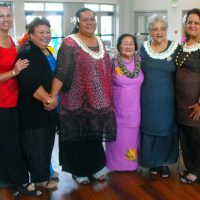
Three books were launched Friday by the Samoan Studies Institute (SSI) at the American Samoa Community College.
First Lady Cynthia Malala Moliga gave the keynote address at the event, which was also attended by members of the ASCC administration, faculty and students, as well as a number of guests from the public and private sector.
For all three of the new publications, editorship was overseen by SSI Director Okenaisa Fauolo-Manila.
The first, Ua Tālā le Ta’ui 3, is a bilingual book of 15 indigenous narratives/folklores from selected villages of Tutuila and the third volume of the SSI’s Tala le Ta’ui series.
The book offers explanations of literary terms and old adages as well as new proverbial sayings at the end of each narrative.
The stories were collected by Tofa Teleiai Christian Ausage, assisted by Mago Maseuli Faleosalafai Tipa and translated by Tipa and Tupaisiva Tamari Mulitalo-Cheung. Credits for layout and graphics go to Patrick Mafo’e and Hannacho Sione and photographs by Vincent Tofilau.
Director Fauolo-Manila acknowledged with great gratitude the role the storytellers or the gatekeepers from the community play in preserving and transmitting knowledge.
“Some of those stories were particular to their individual families, but they were so gracious and supportive of passing indigenous narratives along, especially so our youth would be aware of why some things were seen the way they are.”
At the book launching ceremony, the men and women from various Tutuila villages who lent their input to the SSI publications were seated as guests of honor alongside the First Lady at the front of the College’s Multi-Purpose Center auditorium.
The event included a cultural performance by the Student Association for Faasamoa (SAFF) members, using the traditional sula (praise), which emphasized the high regard the SSI holds for the unconditional sharing of knowledge.
The second new work, Eugagana, is a bilingual glossary compiling terms from over 20 disciplines (Agriculture, Math, English, etc.) collated from resources both local and international.
Some terms were transliterated, and others created from existing concepts and words by SSI faculty and staff. Eugagana attempts to meet a need for general translations by researchers, students and the general public who often call the SSI office with their translation requests.
According to Director Fauolo-Manila, the SSI faculty and staff worked together with neighboring Samoa and other scholars off island.
The third of the new works is Pi faitau – Samoan Alphabet, a volume based on the work of the LMS missionaries who pioneered written Samoan Language.
SSI Researcher and Language Interpreter Mulitalo-Cheung noted that the Pi faitau – Samoan Alphabet took less than a year to complete, while the other two books took considerably longer.
“Tala le Ta’ui took us three years,” she recalled, “and we worked on Eugagana for more than five years, adding terms from additional disciplines as we went along. We’ve learned that among the entities who do these kinds of projects, language translations typically require a lot of time. For instance, during our meeting with the Academie of Tahiti several years ago, they shared that two of their dictionary projects took them eight years for one and a decade for another. ”
While the SSI offers a full range of classes on Samoan language and culture, the Institute has concurrently made producing books a high priority. “Part of the mission of ASCC is to promote awareness of Samoa and the Pacific,” said the Director.
“In effect, this means placing great value on cultural heritage and language, among other areas. Researching, collecting and publishing indigenous narratives add to the pool of resources Samoans and other interested persons everywhere can use. There is a continuous need to standardize, add, revise and create more glossaries and local material. More foreign terms need translation and explaining as the world becomes more connected and advanced.”
In her keynote address, the First Lady related the experience of many ethnic Samoans growing up overseas. The parents of the First Lady and the other girls and boys in Hawaii’s small Samoan community faced a challenge to instill a sense of cultural heritage in them, while also trying to ensure they would succeed in their immediate surroundings.
“I admire how the Japanese community addressed this same situation,” reflected the First Lady. “Their boys and girls would learn proper English all day in school, then spend several more hours afterwards in Japanese school learning their own language and culture. I wish we’d had something similar for the Samoan community, but there were so few of us then. However, in these times the number of Samoans overseas trying to stay connected to their roots has increased substantially, which makes it important for them to have access to resources like the kind being created by the SSI.”
At the conclusion of the ceremony, the First Lady and the guests of honor all received copies of the new publications and other works produced by the SSI.
For interested members of the public, most of the SSI books are available in the ASCC Le Bookstore. For more information on the SSI, visit the ASCC website at www.amsamoa.edu.




